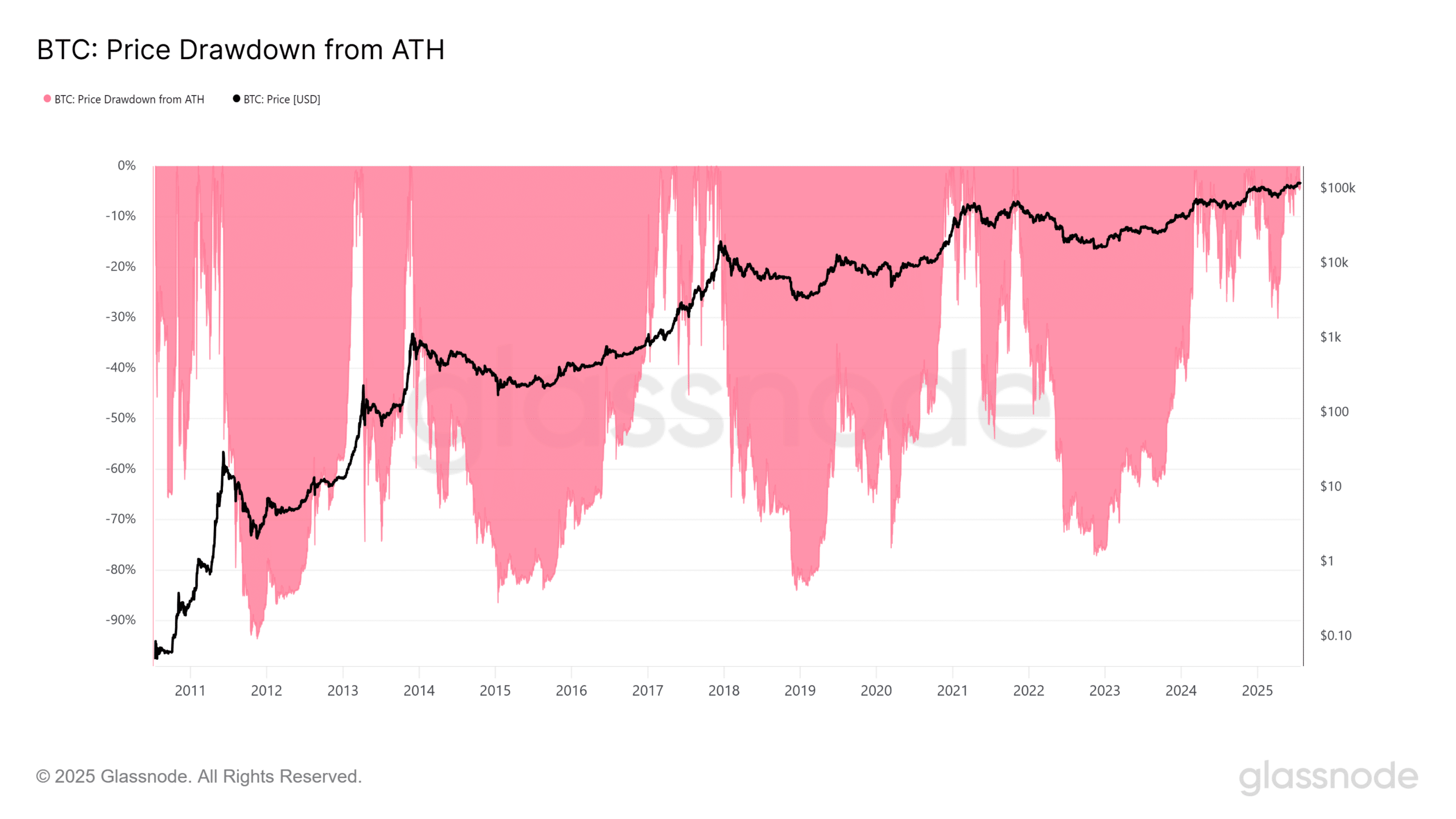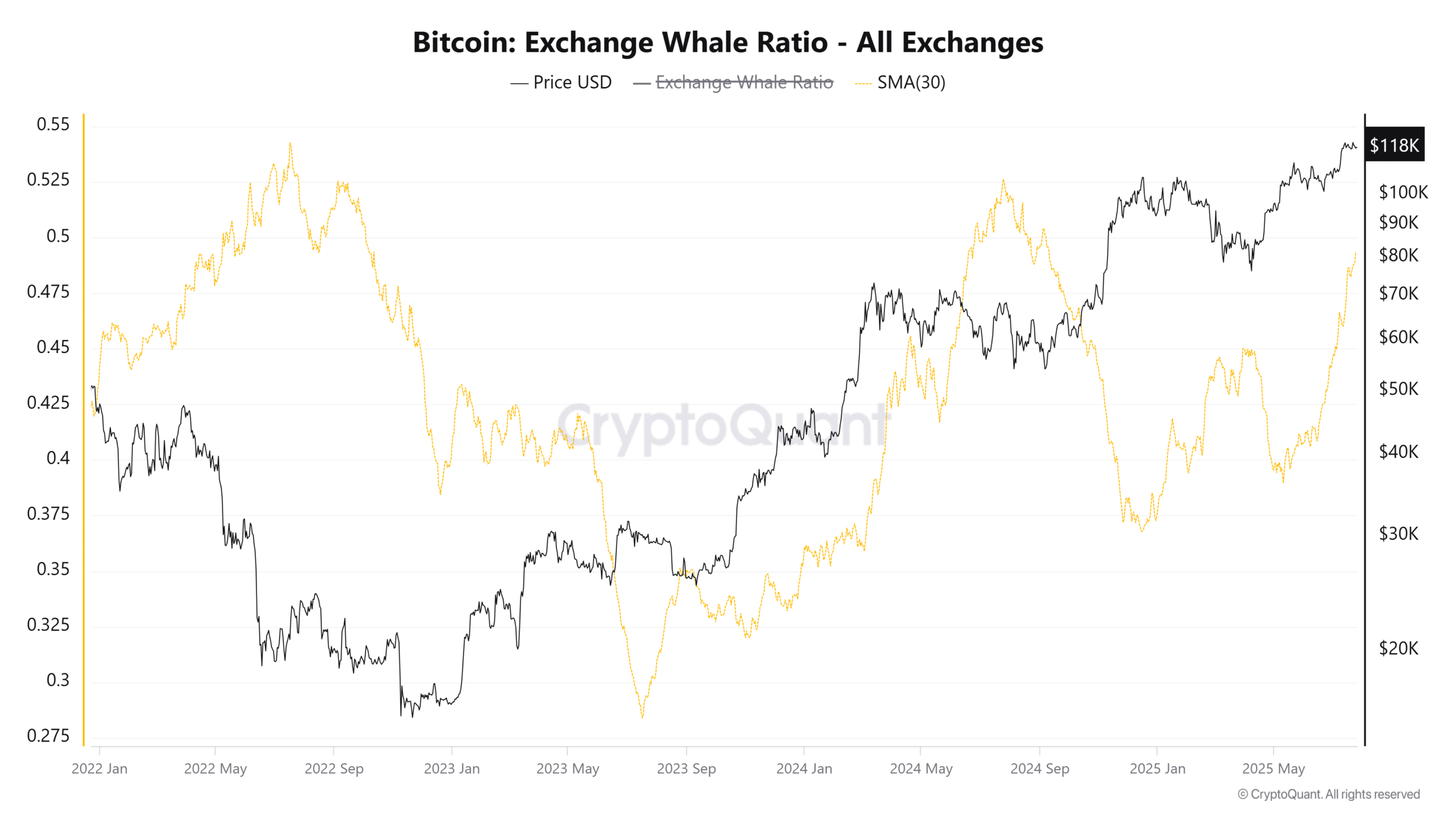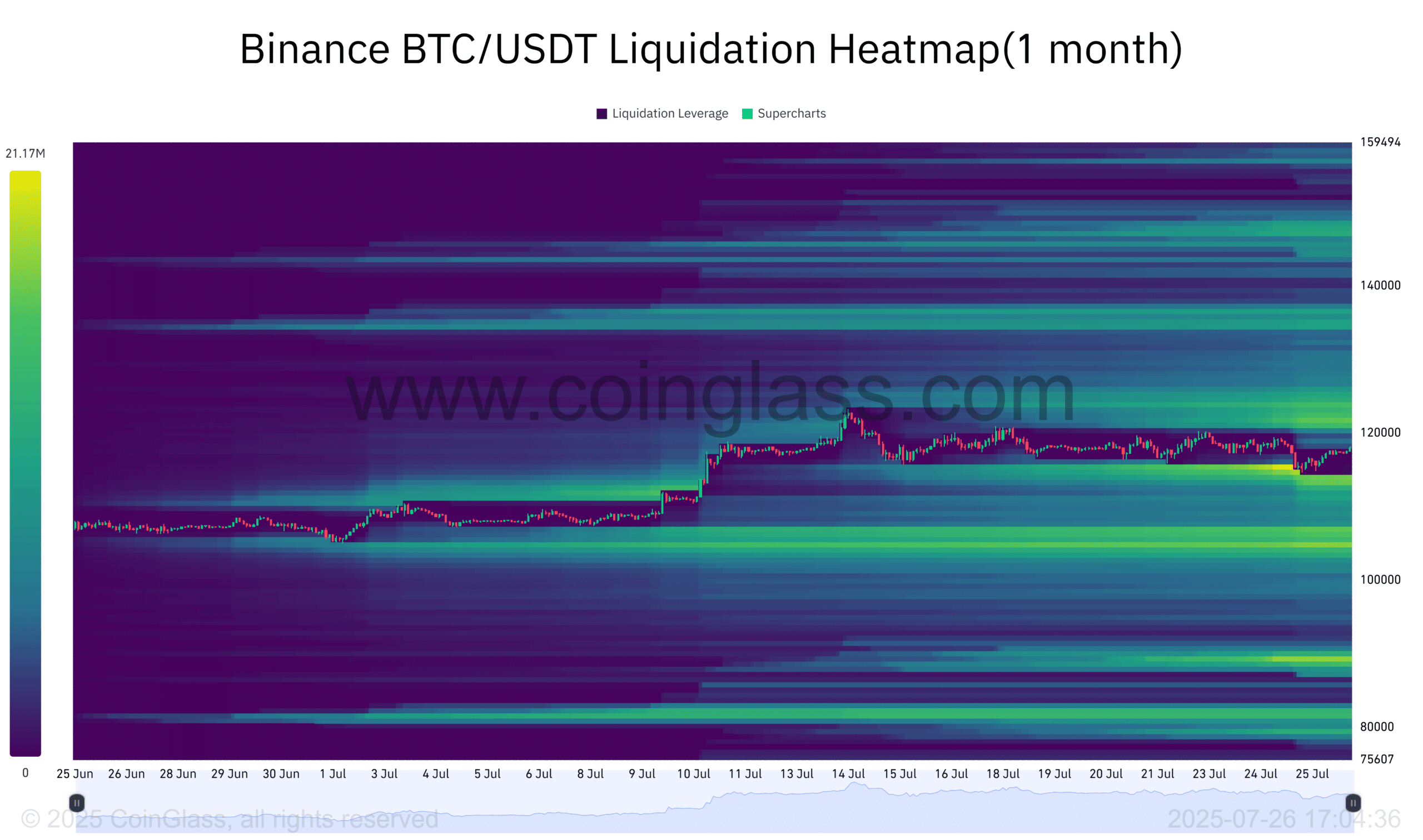| COINOTAG recommends • Exchange signup |
| 💹 Trade with pro tools |
| Fast execution, robust charts, clean risk controls. |
| 👉 Open account → |
| COINOTAG recommends • Exchange signup |
| 🚀 Smooth orders, clear control |
| Advanced order types and market depth in one view. |
| 👉 Create account → |
| COINOTAG recommends • Exchange signup |
| 📈 Clarity in volatile markets |
| Plan entries & exits, manage positions with discipline. |
| 👉 Sign up → |
| COINOTAG recommends • Exchange signup |
| ⚡ Speed, depth, reliability |
| Execute confidently when timing matters. |
| 👉 Open account → |
| COINOTAG recommends • Exchange signup |
| 🧭 A focused workflow for traders |
| Alerts, watchlists, and a repeatable process. |
| 👉 Get started → |
| COINOTAG recommends • Exchange signup |
| ✅ Data‑driven decisions |
| Focus on process—not noise. |
| 👉 Sign up → |
Bitcoin is currently trading just under $118K after a minor 4.24% dip from its all-time high, with bearish social sentiment and a rising exchange whale ratio indicating a possible short-term correction.
-
Bitcoin’s price remains resilient despite a 4.24% pullback from its record $123K high.
-
The exchange whale ratio at 0.52 suggests increased large BTC inflows to exchanges, often preceding price corrections.
-
COINOTAG analysis highlights $118K as a critical resistance level that will determine Bitcoin’s near-term trajectory.
Bitcoin price dips below $118K amid bearish social signals and whale activity; monitor key resistance levels for potential market shifts. Stay updated with COINOTAG.
| COINOTAG recommends • Professional traders group |
| 💎 Join a professional trading community |
| Work with senior traders, research‑backed setups, and risk‑first frameworks. |
| 👉 Join the group → |
| COINOTAG recommends • Professional traders group |
| 📊 Transparent performance, real process |
| Spot strategies with documented months of triple‑digit runs during strong trends; futures plans use defined R:R and sizing. |
| 👉 Get access → |
| COINOTAG recommends • Professional traders group |
| 🧭 Research → Plan → Execute |
| Daily levels, watchlists, and post‑trade reviews to build consistency. |
| 👉 Join now → |
| COINOTAG recommends • Professional traders group |
| 🛡️ Risk comes first |
| Sizing methods, invalidation rules, and R‑multiples baked into every plan. |
| 👉 Start today → |
| COINOTAG recommends • Professional traders group |
| 🧠 Learn the “why” behind each trade |
| Live breakdowns, playbooks, and framework‑first education. |
| 👉 Join the group → |
| COINOTAG recommends • Professional traders group |
| 🚀 Insider • APEX • INNER CIRCLE |
| Choose the depth you need—tools, coaching, and member rooms. |
| 👉 Explore tiers → |
Bitcoin’s Recent Price Movement and Historical Drawdowns
Bitcoin traded just below $118,000 following a 4.24% decline from its all-time high of $123,091. This dip is minor compared to previous bull run corrections, such as the 50% drawdown experienced in July 2021 before reaching $69,000 later that year. Such fluctuations are typical during strong market cycles, indicating that a small pullback is not unusual for Bitcoin’s price action.

| COINOTAG recommends • Exchange signup |
| 📈 Clear interface, precise orders |
| Sharp entries & exits with actionable alerts. |
| 👉 Create free account → |
| COINOTAG recommends • Exchange signup |
| 🧠 Smarter tools. Better decisions. |
| Depth analytics and risk features in one view. |
| 👉 Sign up → |
| COINOTAG recommends • Exchange signup |
| 🎯 Take control of entries & exits |
| Set alerts, define stops, execute consistently. |
| 👉 Open account → |
| COINOTAG recommends • Exchange signup |
| 🛠️ From idea to execution |
| Turn setups into plans with practical order types. |
| 👉 Join now → |
| COINOTAG recommends • Exchange signup |
| 📋 Trade your plan |
| Watchlists and routing that support focus. |
| 👉 Get started → |
| COINOTAG recommends • Exchange signup |
| 📊 Precision without the noise |
| Data‑first workflows for active traders. |
| 👉 Sign up → |
Source: Glassnode
What Does the Exchange Whale Ratio Indicate About Bitcoin’s Short-Term Outlook?
The exchange whale ratio, currently at 0.52, measures the proportion of the top 10 largest Bitcoin inflows to exchanges relative to total inflows. A rising 30-day moving average since May signals growing large-scale BTC deposits on exchanges, which historically precedes short-term price corrections. This metric suggests that Bitcoin may face downward pressure unless it decisively breaks above the $118K resistance.
| COINOTAG recommends • Traders club |
| ⚡ Futures with discipline |
| Defined R:R, pre‑set invalidation, execution checklists. |
| 👉 Join the club → |
| COINOTAG recommends • Traders club |
| 🎯 Spot strategies that compound |
| Momentum & accumulation frameworks managed with clear risk. |
| 👉 Get access → |
| COINOTAG recommends • Traders club |
| 🏛️ APEX tier for serious traders |
| Deep dives, analyst Q&A, and accountability sprints. |
| 👉 Explore APEX → |
| COINOTAG recommends • Traders club |
| 📈 Real‑time market structure |
| Key levels, liquidity zones, and actionable context. |
| 👉 Join now → |
| COINOTAG recommends • Traders club |
| 🔔 Smart alerts, not noise |
| Context‑rich notifications tied to plans and risk—never hype. |
| 👉 Get access → |
| COINOTAG recommends • Traders club |
| 🤝 Peer review & coaching |
| Hands‑on feedback that sharpens execution and risk control. |
| 👉 Join the club → |

Source: CryptoQuant
How Are Liquidation Levels Affecting Bitcoin’s Price Action?
The Bitcoin liquidation heatmap reveals two significant liquidity clusters at approximately $113,200 and $121,800. Currently, the price is nearer to the upper cluster, suggesting a potential upward move. However, if the exchange whale ratio rises above 0.6, traders should prepare for a deeper pullback. These liquidation zones act as magnets for price action, guiding short-term market behavior.

| COINOTAG recommends • Exchange signup |
| 📈 Clear control for futures |
| Sizing, stops, and scenario planning tools. |
| 👉 Open futures account → |
| COINOTAG recommends • Exchange signup |
| 🧩 Structure your futures trades |
| Define entries & exits with advanced orders. |
| 👉 Sign up → |
| COINOTAG recommends • Exchange signup |
| 🛡️ Control volatility |
| Automate alerts and manage positions with discipline. |
| 👉 Get started → |
| COINOTAG recommends • Exchange signup |
| ⚙️ Execution you can rely on |
| Fast routing and meaningful depth insights. |
| 👉 Create account → |
| COINOTAG recommends • Exchange signup |
| 📒 Plan. Execute. Review. |
| Frameworks for consistent decision‑making. |
| 👉 Join now → |
| COINOTAG recommends • Exchange signup |
| 🧩 Choose clarity over complexity |
| Actionable, pro‑grade tools—no fluff. |
| 👉 Open account → |
Source: CoinGlass
What Are the Bullish and Bearish Scenarios for Bitcoin Moving Forward?
Bitcoin’s near-term price action hinges on the $118K resistance level. A sustained breakout accompanied by a declining exchange whale ratio could propel Bitcoin toward $122K-$124K. Conversely, if the ratio remains above 0.5 and Bitcoin fails to reclaim $118K, a deeper correction toward the $111K-$112K demand zone is probable. Market participants should watch these key metrics closely to gauge momentum.
| COINOTAG recommends • Members‑only research |
| 📌 Curated setups, clearly explained |
| Entry, invalidation, targets, and R:R defined before execution. |
| 👉 Get access → |
| COINOTAG recommends • Members‑only research |
| 🧠 Data‑led decision making |
| Technical + flow + context synthesized into actionable plans. |
| 👉 Join now → |
| COINOTAG recommends • Members‑only research |
| 🧱 Consistency over hype |
| Repeatable rules, realistic expectations, and a calmer mindset. |
| 👉 Get access → |
| COINOTAG recommends • Members‑only research |
| 🕒 Patience is an edge |
| Wait for confirmation and manage risk with checklists. |
| 👉 Join now → |
| COINOTAG recommends • Members‑only research |
| 💼 Professional mentorship |
| Guidance from seasoned traders and structured feedback loops. |
| 👉 Get access → |
| COINOTAG recommends • Members‑only research |
| 🧮 Track • Review • Improve |
| Documented PnL tracking and post‑mortems to accelerate learning. |
| 👉 Join now → |
What Should Long-Term Investors Consider Amid Short-Term Volatility?
Despite short-term bearish signals, Bitcoin’s long-term fundamentals remain strong. Institutional interest and network activity continue to support its value proposition. Investors with a longer horizon can view current dips as potential entry points, aligning with historical patterns of recovery following corrections during bull markets.
Key Takeaways
- Minor 4.24% price dip: Bitcoin trades just below $118K after reaching an all-time high of $123,091.
- Exchange whale ratio at 0.52: Indicates rising large BTC inflows to exchanges, often preceding short-term corrections.
- Critical resistance at $118K: A decisive move above this level could lead to gains toward $124K; failure may result in deeper pullbacks.
Conclusion
Bitcoin’s recent price dip and rising exchange whale ratio suggest a cautious short-term outlook, with $118K serving as a pivotal resistance. While bearish signals point to a possible correction, the long-term fundamentals remain intact, offering optimism for investors. Monitoring these key metrics will be essential for navigating the evolving market landscape.
| COINOTAG recommends • Exchange signup |
| 🎯 Focus on process over noise |
| Plan trades, size positions, execute consistently. |
| 👉 Sign up → |
| COINOTAG recommends • Exchange signup |
| 🛠️ Simplify execution |
| Keep decisions clear with practical controls. |
| 👉 Get started → |
| COINOTAG recommends • Exchange signup |
| 📊 Make data your edge |
| Use depth and alerts to avoid guesswork. |
| 👉 Open account → |
| COINOTAG recommends • Exchange signup |
| 🧭 Be prepared, not reactive |
| Turn setups into rules before you trade. |
| 👉 Create account → |
| COINOTAG recommends • Exchange signup |
| ✍️ Plan first, then act |
| Entries, exits, and reviews that fit your routine. |
| 👉 Join now → |
| COINOTAG recommends • Exchange signup |
| 🧩 Consistency beats intensity |
| Small, repeatable steps win the long run. |
| 👉 Sign up → |
Frequently Asked Questions
What does a rising exchange whale ratio indicate for Bitcoin’s price?
A rising exchange whale ratio suggests that large holders are moving Bitcoin to exchanges, which can increase selling pressure and lead to short-term price declines.
| COINOTAG recommends • Premium trading community |
| 🏛️ WAGMI CAPITAL — Premium Trading Community |
| Strategic insights, exclusive opportunities, professional support. |
| 👉 Join WAGMI CAPITAL → |
| COINOTAG recommends • Premium trading community |
| 💬 Inner Circle access |
| See members share real‑time PnL and execution notes in chat. |
| 👉 Apply for Inner Circle → |
| COINOTAG recommends • Premium trading community |
| 🧩 Turn theses into trades |
| Reusable templates for entries, risk, and review—end to end. |
| 👉 Join the club → |
| COINOTAG recommends • Premium trading community |
| 💡 Long‑term mindset |
| Patience and discipline over noise; a process that compounds. |
| 👉 Get started → |
| COINOTAG recommends • Premium trading community |
| 📚 Education + execution |
| Courses, playbooks, and live market walkthroughs—learn by doing. |
| 👉 Get access → |
| COINOTAG recommends • Premium trading community |
| 🔒 Members‑only research drops |
| Curated analyses and private briefings—quality over quantity. |
| 👉 Join WAGMI CAPITAL → |
Is Bitcoin’s recent dip a sign of a bear market?
Not necessarily. Minor dips are common during bull runs, and current data points to a possible short-term correction rather than a full bear market.
| COINOTAG recommends • Members‑only research |
| 📌 Curated setups, clearly explained |
| Entry, invalidation, targets, and R:R defined before execution. |
| 👉 Get access → |
| COINOTAG recommends • Members‑only research |
| 🧠 Data‑led decision making |
| Technical + flow + context synthesized into actionable plans. |
| 👉 Join now → |
| COINOTAG recommends • Members‑only research |
| 🧱 Consistency over hype |
| Repeatable rules, realistic expectations, and a calmer mindset. |
| 👉 Get access → |
| COINOTAG recommends • Members‑only research |
| 🕒 Patience is an edge |
| Wait for confirmation and manage risk with checklists. |
| 👉 Join now → |
| COINOTAG recommends • Members‑only research |
| 💼 Professional mentorship |
| Guidance from seasoned traders and structured feedback loops. |
| 👉 Get access → |
| COINOTAG recommends • Members‑only research |
| 🧮 Track • Review • Improve |
| Documented PnL tracking and post‑mortems to accelerate learning. |
| 👉 Join now → |










